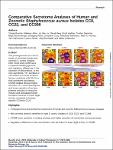Comparative Secretome Analyses of Human and Zoonotic Staphylococcus aureus Isolates CC8, CC22, and CC398
Busche, Tobias
Hillion, Mélanie
Van Loi, Vu
Berg, David
Walther, Birgit
Semmler, Torsten
Strommenger, Birgit
Witte, Wolfgang
Cuny, Christiane
Mellmann, Alexander
Holmes, Mark A.
Kalinowski, Jörn
Adrian, Lorenz
Bernhardt, Jörg
Antelmann, Haike
The spread of methicillin-resistant Staphylococcus aureus (MRSA) in the community, hospitals and in livestock is mediated by highly diverse virulence factors that include secreted toxins, superantigens, enzymes and surface-associated adhesins allowing host adaptation and colonization. Here, we combined proteogenomics, secretome and phenotype analyses to compare the secreted virulence factors in selected S. aureus isolates of the dominant human- and livestock-associated genetic lineages CC8, CC22, and CC398. The proteogenomic comparison revealed 2181 core genes and 1306 accessory genes in 18 S. aureus isolates reflecting the high genome diversity. Using secretome analysis, we identified 869 secreted proteins with 538 commons in eight isolates of CC8, CC22, and CC398. These include 64 predicted extracellular and 37 cell surface proteins that account for 82.4% of total secretome abundance. Among the top 10 most abundantly secreted virulence factors are the major autolysins (Atl, IsaA, Sle1, SAUPAN006375000), lipases and lipoteichoic acid hydrolases (Lip, Geh, LtaS), cytolytic toxins (Hla, Hlb, PSMβ1) and proteases (SspB). The CC398 isolates showed lower secretion of cell wall proteins, but higher secretion of α- and β-hemolysins (Hla, Hlb) which correlated with an increased Agr activity and strong hemolysis. CC398 strains were further characterized by lower biofilm formation and staphyloxanthin levels because of decreased SigB activity. Overall, comparative secretome analyses revealed CC8- or CC22-specific enterotoxin and Spl protease secretion as well as Agr- and SigB-controlled differences in exotoxin and surface protein secretion between human-specific and zoonotic lineages of S. aureus.
Files in this item

